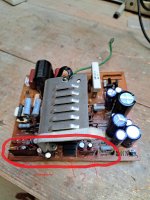i did a full recap replaced the degauser block 'monitor turns off after couple of sec
i tested the flyback by disconnecting the neckboard monitor stays on so flyback is stil good !
friend says x ray protection is kiking in and shuts down the monitor
any one has a schematic for a
thanks
i tested the flyback by disconnecting the neckboard monitor stays on so flyback is stil good !
friend says x ray protection is kiking in and shuts down the monitor
any one has a schematic for a
IBM 8514
thanks




